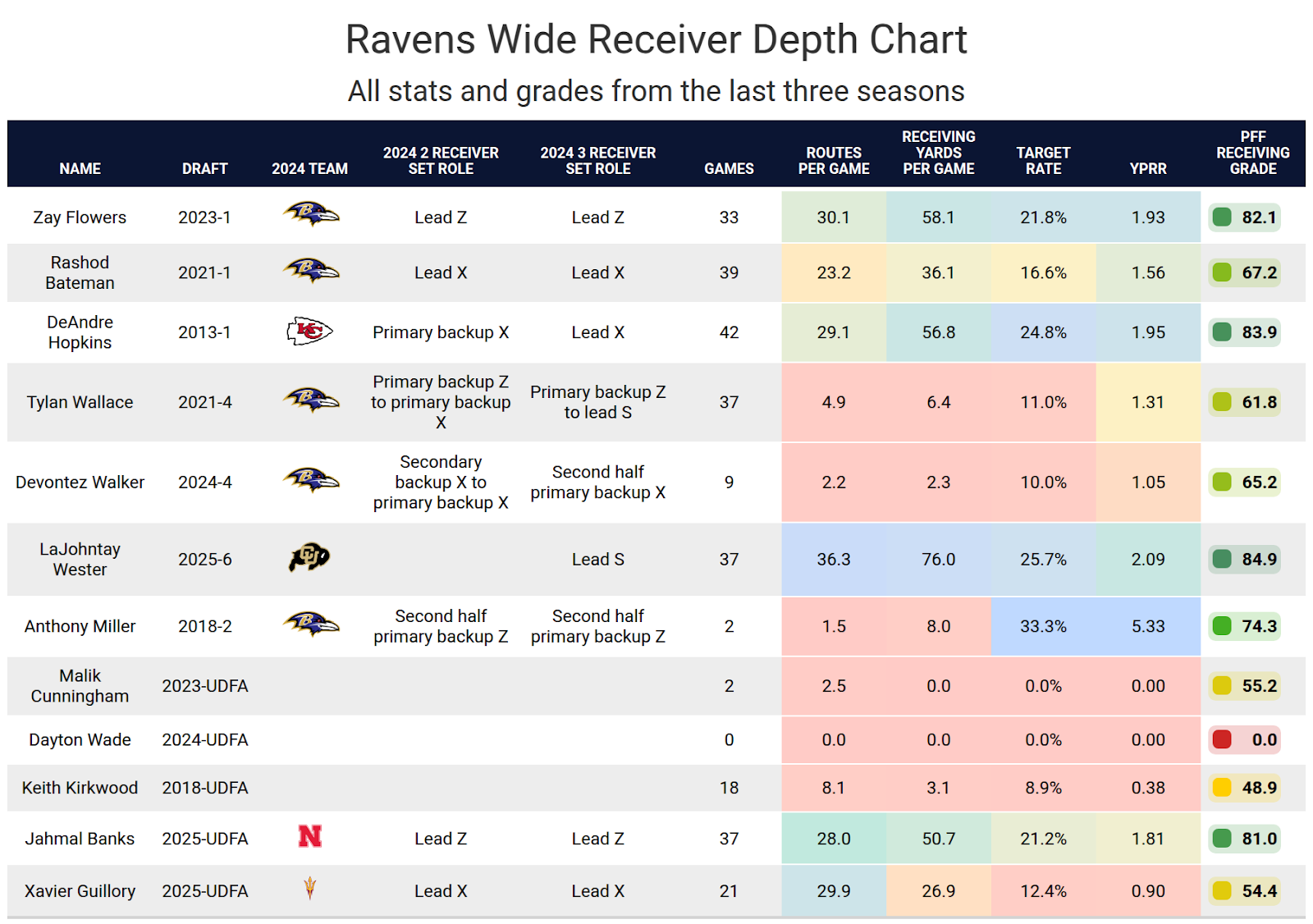- Zay Flowers‘ improvement helps the Baltimore Ravens: Flowers improved his PFF receiving grade and many of his rate stats in 2024, but he still ended up with fewer fantasy points per game.
- Flowers should play more from the slot: Flowers had played better out of the slot, and the Ravens moved on from their previous slot receiver, Nelson Agholor.
- Subscribe to PFF+: Get access to player grades, PFF Premium Stats, fantasy football rankings, all of the PFF fantasy draft research tools and more!
Estimated Reading Time: 5 minutes

PFF’s Fantasy Football Player Profile series delivers the most in-depth fantasy football analysis available for the 2025 season.
Using PFF’s exclusive data, we evaluate player performance, competition for touches and how teammates and coaching staffs
Last updated: 7:15 a.m. Wednesday, May 21
Player performance
Ravens' wide receivers had minimal fantasy success in the early years of the Lamar Jackson era. From 2019-2022, the only wide receiver with at least 50 receptions in a season was Hollywood Brown in 2020 and 2021. Flowers was the Ravens’ first-round pick in 2023, and he’s reached at least 70 receptions in his first two seasons with the team.
Baltimore switched to more of a pass-heavy offense in 2023 after years with Greg Roman at offensive coordinator. Flowers played an average of 84.7% of the Ravens’ offensive snaps, which he managed at least 84% of the snaps in most games, but it dropped in some Ravens blowout victories. He was a typical borderline WR2/WR3, where he had at least 60 yards in half of his games and multiple blowout games where he only caught one pass. If anything, he was less risky than a usual player in that range because he didn’t have a high touchdown total and didn’t have many big plays. Fantasy managers had reason to be excited about Flowers heading into 2024 after his 115-yard, one-touchdown performance in their conference championship loss to the Kansas City Chiefs despite the lost fumble.
Flowers took some significant steps forward in 2024. He handled a higher catch rate and was used down the field more often, leading to a much higher yards per route run and receiving grade. He had five games with five or more receptions and over 100 receiving yards.
The problem is that the Ravens added Derrick Henry, leading the team to be more run-heavy. The Ravens also dominated too many games, so Flowers’ snap rate lowered dramatically. There were only three games that Flowers dipped below 75% in 2023, all 30-plus-point blowouts. In 2024, there were seven games where his snap rate fell below 75%, with an 18.6 average margin of victory in those games. He exceeded 83% of the snaps in six games, five of which were losses. He had three games with a single catch. While his quality of play was much better, his fantasy points per game took a dip because his receptions per game dropped by 0.4, and he scored fewer touchdowns.
One of those three games was in Week 18, where he suffered a knee injury early on, which cost him the NFL playoffs. The latest update is that Flowers didn’t need surgery, is feeling great and should be ready.
Flowers has stood out the most in his ability to avoid tackles. Over the last two seasons, he ranks second in avoided tackles per reception (0.285), third in avoided tackles per route (0.043) and seventh in avoided tackles per game (1.30).


Projected role
Rashod Bateman was the Ravens‘ X receiver, while Flowers was the Z and Nelson Agholor was manning the slot for the last two seasons. Flowers’ slot snap rate jumped up from 34.8% to 41.7%. Baltimore moved away from using a ton of 11 personnel last season and instead focused more on 12 personnel with Mark Andrews and Isaiah Likely, including some third-and-long situations. Flowers had 12 of his receptions for 237 yards on just 64 routes when lining up in the slot out of 12 personnel, which was nearly 100 more yards than any other wide receiver out of the slot in 12 personnel. Flowers has 2.10 yards per route run out of the slot compared to 1.85 when lined up out wide.
The Ravens moved on from Agholor, who had 102 routes from the slot in 11 personnel last season compared to Flowers' 87. The Ravens added DeAndre Hopkins in free agency. He’s traditionally been an X receiver, as has Bateman, but the Ravens might still put them both on the field in 11 personnel, in which case Flowers is the clear slot player. There is also a chance Tylan Wallace will take on a larger role, and Wallace has at least some experience in the slot. Baltimore also spent a sixth-round draft pick on LaJohntay Wester, who also has experience in the slot. There is also a chance that Baltimore shifts even further into using more 12 personnel.
In most of these scenarios, this should mean more of Flowers in the slot, which should help his production. The only problem is his end zone target share hasn’t been that high, and there isn’t much reason to expect that to change. That might go down with Hopkins as part of the offense.


Impact of teammates
Flowers is entering his third season with Todd Monken as his offensive coordinator and Lamar Jackson as his quarterback. Having an MVP quarterback certainly makes Flowers’ life easier, and Monken has helped Baltimore become a very high-scoring offense. The low wide receiver target rate is understandable given Mark Andrews and Isaiah Likely‘s presence. The low use of 11 personnel hasn’t been a problem because they are fine moving Flowers into the slot in 12 personnel.


Bottom line
Flowers is a fine player to draft and start in weeks where the Ravens have a competitive game. He could have a potential top-10 season if the Ravens' defense completely falls apart, leaving the Ravens in more competitive games. However, Baltimore is too great of a team with too many good options on offense, which makes it impossible for Flowers to have consistent fantasy value each week.

Footnotes
- Statistics in tables and charts were chosen based on their ability to predict future fantasy performance on a per-game or per-opportunity basis or to describe the player relative to others at the same position.
- “Opportunities” are defined as passing dropbacks, rushing attempts and routes run as a receiver.
- Numbers are provided either by season or based on the past three years. For rookies, only college statistics are included. For non-rookies, only NFL statistics are considered, regardless of whether they played in college within the previous three years.
- As college competition is easier than NFL competition, most rookies are likely to see a decline from their historical numbers.
- Only FBS data is considered for college players and comparisons.
- Kneel-downs are removed from rushing data to provide cleaner quarterback rushing rate statistics.
- The table colors in this article range from blue (indicating good/high) to red (indicating bad/low).
- All percentiles and color codings compare the given player to others with a high sample of opportunities. Generally, the cutoff is one-third of the possible opportunities in the sample. If a player does not meet the threshold, they are still included in the comparison, though their results may appear better or worse than expected due to the smaller, less predictive sample size.
- Information on utilization classifications and their importance can be found here for running backs, wide receivers and tight ends.



 © 2025 PFF - all rights reserved.
© 2025 PFF - all rights reserved.